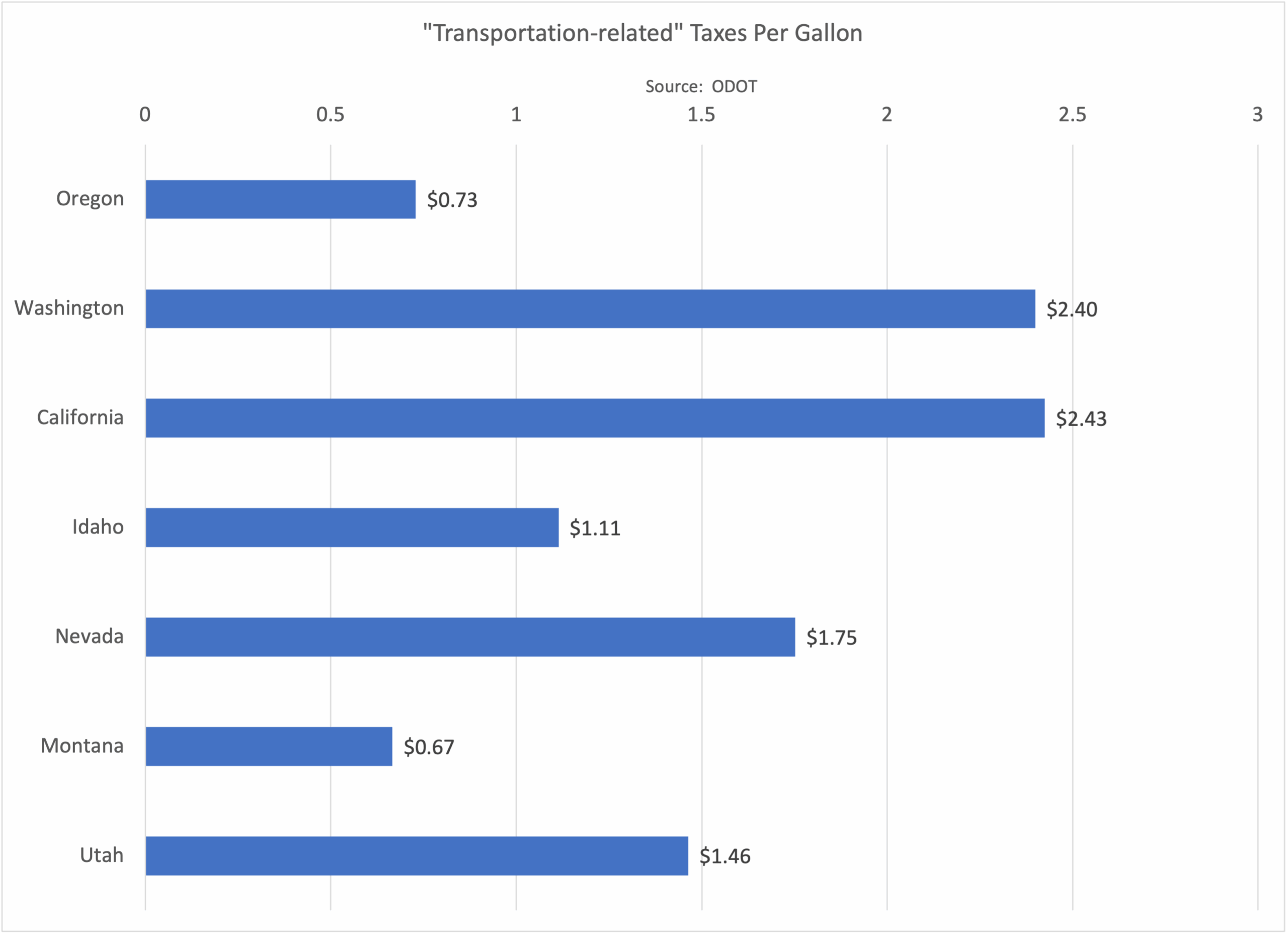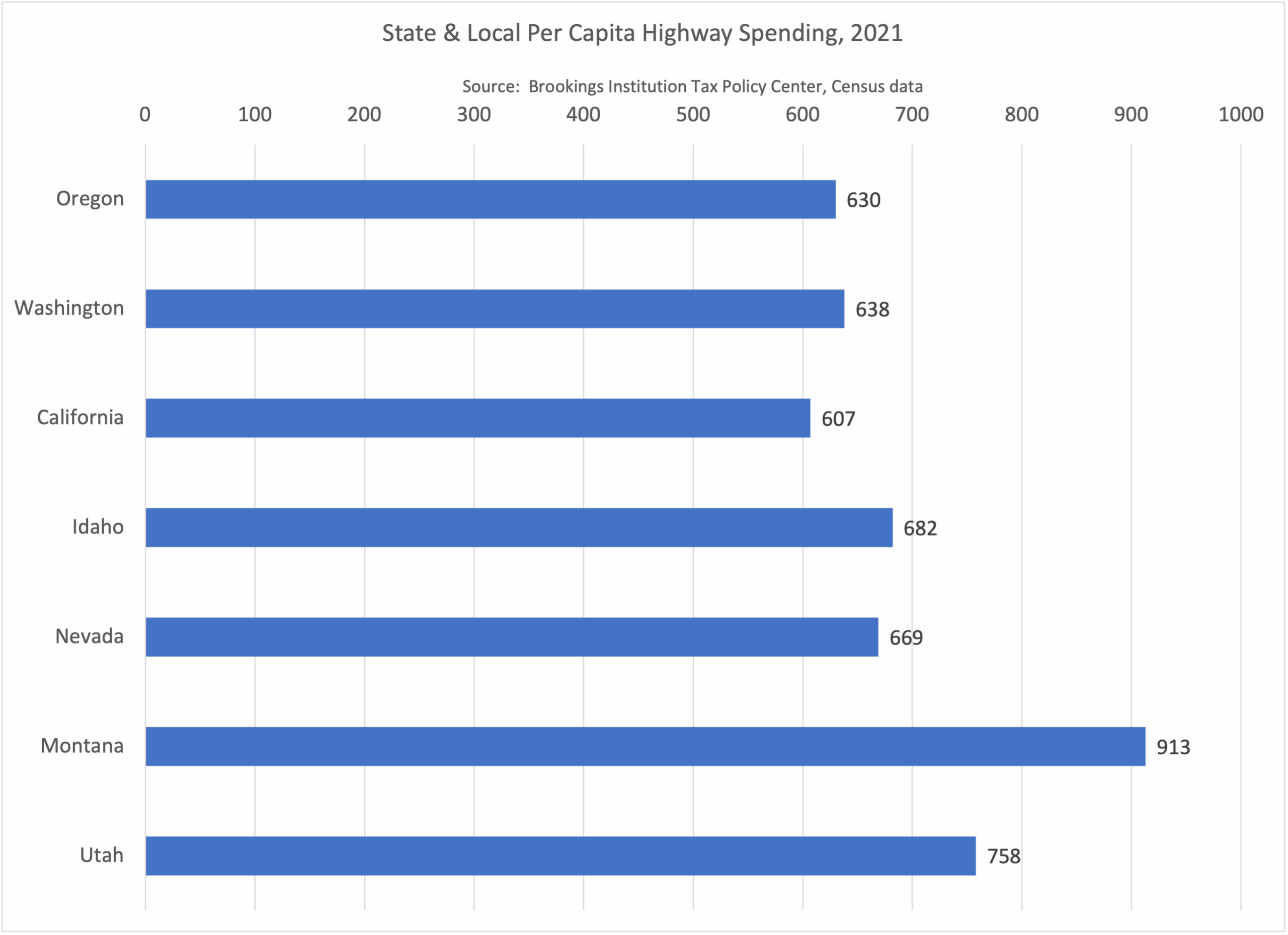ODOT’s claim that Oregon spends less on roads than neighboring states was a key talking point in trying to sell a higher transportation tax in the 2025 Legislature
Based on ODOT”s data, legislators repeatedly claimed that Oregon spends less on roads than other Western states
The trouble is it’s not true. Big state sales taxes on cars warp the comparison. Other states do charge sales taxes on car sales, but this money goes to general funds, not to road construction and repair
Independent national comparisons prepared by the widely respected Brookings Institution, using Census Bureau data from all 50 states shows Oregon spends almost the same on roads as neighboring states, about $630 per capita in 2021.
ODOT’s numbers are a bogus and deceptive sales technique, not an objective analysis
ODOT’s Big Lie: Oregon spends less on roads than other states
The idea that Oregon’s taxes for transportation are much lower than neighboring states has become a widely repeated talking point in the State Capitol.
All of this buzz traces back to a pair of memos prepared before the 2025 legislative session, by the Oregon Department of Transportation. ODOT created these to generate talking points for legislators to help sell higher gas taxes and registration fees. In a memo entitled “How Oregon and Other States Pay for Roads” ODOT claims that Oregonians pay less in “automobile-related” taxes than nearby western states.
Oregon’s total vehicle taxes and fees are lower than almost any other state, as most states apply sales taxes to vehicles or have annual taxes based on the vehicle’s value (known as an ad valorem tax). An ODOT analysis of seven western states that converts vehicle taxes and fees into a fuels tax per gallon equivalent shows that Oregon’s total vehicle taxes come in next to last at an average of 72.9 cents per gallon
ODOT took a broad definition of vehicle taxes, and included sales and property taxes charged to car owners, and then computed them on a per gallon basis. Graphically, their comparison looks like this:
On its face, these data make it seem like Oregon is way behind other states in taxing cars and drivers, and by implication, spending on its road system. These data make it look like California and Washington pay taxes equal to nearly $2.40 per gallon, while Oregonians pay only about 75 cents.
Legislative advocates, like House Speaker Julie Fahey, repeated ODOT’s numbers as proof that Oregon spends less on road maintenance than other states.
“We are the lowest of the seven Western states in what we spend on roads and bridges that has real world consequences for the safety of Oregonians, for how we maintain our roads and bridges, and we proposed something that would solve that problem.”KATU-TV, July 13, 2025 (Emphasis added)
Oregon lacks ways of raising sufficient revenue for maintenance, with Oregonians paying some of the lowest transportation-related fees in the nation.Oregonian, July 27, 2025. (Emphasis added)
The big difference here is California, Washington and other states charge sales taxes on new car sales, and Oregon, as everyone knows, doesn’t have a sales tax. But what’s more important is that sales taxes on cars in these states aren’t dedicated to road construction and maintenance–they go to each state’s general fund, which pays for everything from schools to health care to housing, and more. You cannot conclude from this data that other states either “have more revenue for maintenance” or “spend more on roads” because a huge chunk of the taxes they’re talking about are used for general government purposes, not road finance.
And the definition of “transportation-related” crafted by ODOT is highly selective. It includes sales taxes but leaves out, for example, income taxes. Why not count the income taxes that Oregon drivers pay on the income that they use to buy automobiles and gasoline as “transportation-related?” It’s an arbitrary choice that misleads and is easily misinterpreted. Similarly, ODOT’s memo counts the property tax and registration fees that Washington residents pay to support transit in the Puget Sound area, but don’t count the payroll taxes levied on Oregon workers to support transit in the Portland area. All these choices are designed to make Oregon look like a low tax and low spending state.
The real issue is how much states spend on transportation, not whether one can craft an arbitrary definition that skews the apparent sources of revenue used by different states into a plainly unrealistic and largely meaningless picture.
Oregon Road Spending is Similar to California and Washington
Fortunately, we have independent and reliable comparisons of state and local spending on transportation. The Census Bureau conducts a uniform national survey of state and local finances. The Tax Policy Center of the Brookings Institution has used these data to construct state-by-state estimates of highway spending per capita. These independent data show Oregon is no laggard.
There’s no evidence that Oregon has “underfunded” its transportation system by comparison to other Western states. Most Western states in the ODOT sample spend between about $600 and $700 per capita annually on state and local roads and bridges, according to Census data. Only low density Montana–with few people, far apart–spends significantly more on roads per capita than Oregon. Oregon’s spending per capita is nearly identical to Washington and California.
Intentionally Misleading Claims
The ODOT analysis is plainly biased: constructed in such a way to make Oregon appear to be a low-spending state to help bolster the political case for ODOT’s request for more money. It’s clear ODOT knew, but concealed key facts. For example, the admission that ODOT’s analysis includes both taxes used for roads and those that go to the general fund of each state is only disclosed in the “explanatory notes”, which is a separate document, which says,
The comparison shows that typical motorist taxes and fees are lower in Oregon and Montana than in other western states, regardless of whether the money is spent on highways or not.
This is not a trivial omission: The biggest factor separating Oregon from California and Washington is ODOT’s attribution of car sales taxes being worth the equivalent of nearly $1.00 per gallon in taxes. The key report “How Oregon and Other States Pay for Roads” conveniently omits any mention of the fact that the money states collect from sales taxes on new cars goes not to pay for roads, but instead to their general funds. Unlike ODOT, which clearly has an axe to grind on this issue, neither the Brookings Institution’s Tax Policy Center, nor the Census Bureau has any interest in raising or lowering Oregon transportation taxes and fees.



